463 Search Results for autism
May 9, 2019
by Carole Zangari -
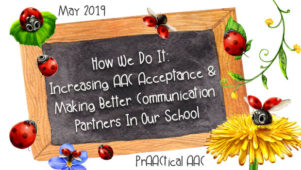
We are pleased to welcome Beth Waite-Lafever, an SLP with over 30 years of AAC experience, back to these pages. She has worked in outpatient rehab, private practice, and public school and has the RESNA ATP credential and LAMP certification from The Center for AAC and Autism. Beth has given many presentations at the state, national and international levels on AAC and related topics. In her private practice, she has provides evaluations, therapy, and training. Beth is the proud co-creator of The Indiana AAC Summit. Currently, she provides monthly online training for PRC as a contracted employee and is an SLP and AT Coach for MSD Martinsville, a public school system in Martinsville, Indiana. :::::::::::::::::::::::::::::::::::::::::::::::::::::::::::::::::::::::::::::::::::::::::::::::::::::::::::::::::::::::::::::::::::::::: How We Do It: Increasing AAC Acceptance and Making Better Communication Partners In Our School Each May when I see the Better Hearing and Speech campaign gear up, I wonder what more I can do... [Read More...]
May 5, 2019
by Carole Zangari -
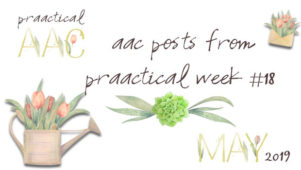
Happy Sunday, AAC friends! Here are some posts that may be of interest. Monday – PrAACtically May: More AAC Resources for A Year of Core Vocabulary Words Tuesday – AAC Link Up Wednesday – Video of the Week: Looking at AAC Modeling Thursday – How We Do It: Coaching AAC Use in the Natural Environment :::::::::::::::::::::::::::::::::::::::::::::::::::::::::::::::::::::::::::::::::::::: Before you go, check out these posts from the archives. It’s PrAACtically Mother’s Day- 5 Activities that Support Communicating with Mom Using Vest Displays with Preschoolers on the Autism Spectrum Aided Language Input During Play Five Resources for Making and Using Visual Scene Displays From Solitary Play to Interaction: 5 Things to Try With Kids Who Love Their iPad Games
April 21, 2019
by Carole Zangari -
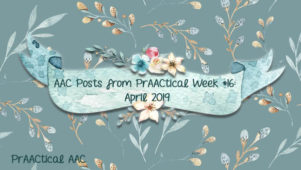
Happy Easter and Passover, AAC friends. Enjoy your day and stop back to check out these posts from our prAACtical week. Monday – Autism Acceptance Resources for Children Tuesday – AAC Link Up Wednesday – Video of the Week: How To Speak When You Don’t Have a Voice Thursday – How Much Do We Understand When Context Cues Are Removed? :::::::::::::::::::::::::::::::::::::::::::::::::::::::::::::::::::::::::::::::::::::::::::::::::::::::::::::::::::::::::::::::::::::::::::::::: Ready for some more reading? Here are a handful of suggestions. PrAACtical Passover and Easter Supports Let’s Read: Getting to the Core of Earth Day Let’s Create: Getting to the Core of Earth Day PrAACtically SLPs: Hungry for Bilingual AAC
April 7, 2019
by Carole Zangari -
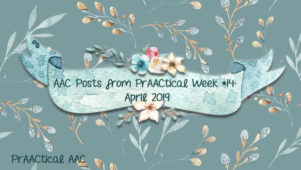
Happy Sunday, AAC friends. Monday – 30 Ideas for Celebrating Autism Awareness and Acceptance Month Tuesday – AAC Link Up Wednesday – Video of the Week: Compliance Is Not the Goal Thursday – How I Do It: Understanding Systems Change :::::::::::::::::::::::::::::::::::::::::::::::::::::::::::::::::::::::::::::::::::::::::::::::::::::::::::::::::::::::::::::::::::::::::::::::::::::::::: If you have time, stick around for a bit more AAC reading. Building Engagement in Young Children with Autism Autism and AAC: 5 Pinterest Boards to Follow AACtual Therapy: Making Core Words Fun for Students with Autism How I Do It: Using PODD books and Aided Language Displays with Young Learners with Autism Spectrum Disorder Evidence-based AAC Strategies for Students with Autism with Betsy Caporale
April 4, 2019
by Carole Zangari -
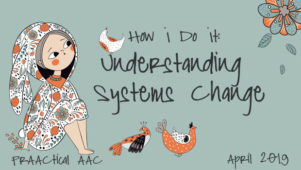
Have you ever dreamed of taking a detour in your AAC work to address the needs from a totally different direction? Special educator Sarah Mueller did just that. Follow along as she tells us about her journey from teacher to student. :::::::::::::::::::::::::::::::::::::::::::::::::::::::::::::::::::::::::::::::::::::::::::::::::: “Autism isn’t something a person has or a ‘shell’ that a person is trapped inside. There’s no normal child hidden behind the autism. Autism is a way of being. It is pervasive; it colors every experience, every sensation, perception, thought, emotion, and encounter, every aspect of existence. It is not possible to separate the autism from the person – and if it were possible, the person you’d have left would not be the same person you started with. This is important, so take a moment to consider it: Autism is a way of being. It is not possible to separate the person from the autism.” – Jim Sinclair... [Read More...]
April 3, 2019
by Carole Zangari -

For our first video of April, which is designated as Autism Awareness and Acceptance Month, we’re turning to the Tedx stage to hear from Dr. Amy Laurent. An occupational therapist by profession, Dr. Laurent shares how her views of autism have changed in her presentation, Compliance Is Not the Goal: Letting Go of Control and Rethinking Support for Autistic Individuals. Enjoy! Direct Link to Video: https://www.youtube.com/watch?time_continue=4&v=fx3cfzlCG_Q
March 31, 2019
by Carole Zangari -
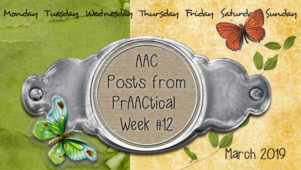
Happy Sunday, AAC friends! Can you believe March is almost over?! We’ll have lots to share for Autism Awareness and Acceptance Month tomorrow. In the meantime, here are some posts from our prAACtical week. Monday – PrAACtically April: AAC Resources for A Year of Core Words Tuesday – AAC Link Up Wednesday – Video of the Week: Moving Beyond Single Words with AAC Thursday – When Materials Aren’t Effective in AAC Teaching: 5 Things to Try :::::::::::::::::::::::::::::::::::::::::::::::::::::::::::::::::::::::::::::::::::::::::::::::::::::::::::::::::::::::::::::::::::::::::::::::::::::::::::::: Have a little more time? Here are a couple of additional posts that you might find interesting. Let’s Read! Getting to the Core of Earth Day Let’s Create! Getting to the Core of Earth Day Let’s Go Outside: 5 PrAACtical Ideas Implementing Object-based Schedules in the Classroom Activity Schedule AACtion
March 18, 2019
by Carole Zangari -
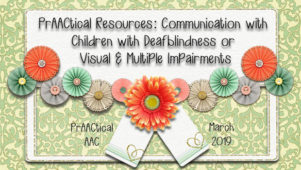
Many of us work with learners who have significant visual difficulties along with another disability such as hearing loss, autism, or intellectual disabilities. Today, we look at the Communication Resources from the Texas School for the Blind and Visually Impaired which is geared to helping teachers, therapists, and parents get familiar with some basic communication principles and instructional strategies. It includes sections on topics such as interaction/bonding, building security, play, calendars, and a video series by Sara Kitchener. Enjoy!
February 13, 2019
by Carole Zangari -
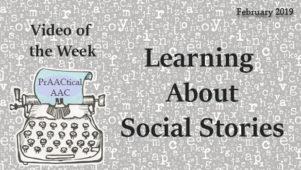
Social stories(TM) are a type of narrative that are used to help learners with social pragmatic and other difficulties gain a greater understanding of a particular context, skill, or concept. For example, we may use social stories to help a preschooler understand what happens in a fire drill or at a birthday party. We may write social stories for a high school student who asks overly personal questions or talks only about their own favorite topics. First developed by Carol Gray, these stories are written using a specific process so that they meet 10 defining criteria. Both the process of writing social stories and the narrative structure that is used in this genre differentiates them from other types of social narratives. You can see examples of well-written social stories here and learn more about the early history of social stories here. Ready to get started learning how to write ‘real’ social... [Read More...]
January 21, 2019
by Carole Zangari -
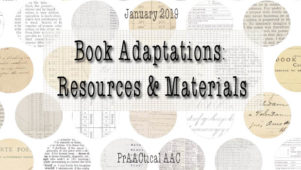
This is an updated version of a post originally authored by Dr. Robin Parker in 2013. We hope you find something of value in the resources that were shared. ::::::::::::::::::::::::::::::::::::::::::::::::::::::::::::::::::::::::::::::::::::::::::::::::::::::::::::::::::::::::::: To integrate reading and writing into communication and language learning we need to have lots of books that are easily accessible. Books should be accessible physically as well as through content and interest. This holds true for ALL learners even those that don’t like books but do like…… wheels. We have made literacy accessible for a young girl who only liked elevators, and a boy who only liked balls, and a young adult who liked Barney books but not much else. It holds true for ALL disabilities and ALL levels of reading and writing. Today, we share resources for making and using adapted books to make literacy more accessible. Check out these awesome resources for making your own adapted books... [Read More...]









